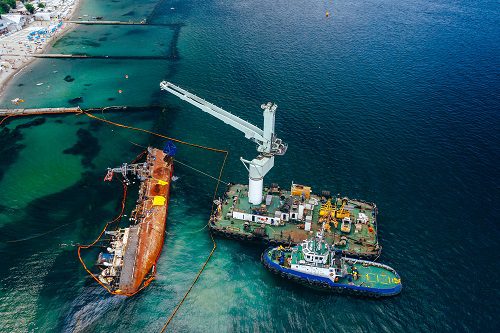Business
Deep Offshore Technology: Transforming the Future of Energy Exploration

Introduction
Energy demand continues to grow around the world, and while renewable sources are expanding, oil and gas still play a central role in meeting global needs. As easily accessible reserves decline, the industry has turned to new frontiers. One of the most important of these frontiers is the deep offshore environment. Deep offshore technology makes it possible to explore and produce hydrocarbons from areas once considered unreachable, often located thousands of meters below the ocean surface.
This article explores what deep offshore technology is, how it works, and why it matters. We will also look at the innovations driving the field, the challenges companies face, and the opportunities it presents for the future of global energy.
What Is Deep Offshore Technology?
Deep offshore technology refers to the advanced methods, systems, and equipment designed for oil and gas operations in deep and ultra-deepwater environments. These areas are generally deeper than 400 meters, with some projects taking place at depths greater than 3,000 meters.
The challenges of working in such conditions are immense. Water pressure is extreme, temperatures are low, and locations are often remote from shore. To meet these challenges, engineers have developed floating production platforms, subsea systems, and robotic technologies that allow operations to be conducted safely and efficiently.
Why Deep Offshore Technology Matters
The significance of deep offshore technology lies in the size of reserves found in deepwater basins. Some of the world’s largest oil and gas discoveries over the last two decades have come from offshore fields, including regions like Brazil’s pre-salt layer, the Gulf of Mexico, and West Africa.
Developing these resources requires more than just drilling deeper wells. It involves integrating multiple technologies to transport hydrocarbons from the seabed to processing facilities while maintaining safety and reliability. Without these advances, vast amounts of oil and natural gas would remain untapped.
Key Components of Deep Offshore Technology
Floating Production Systems
Traditional offshore platforms fixed to the seabed are impractical in very deep waters. Instead, floating production systems are used. These include:
- FPSOs (Floating Production, Storage, and Offloading units): Ships that process and store oil, with the ability to offload it to tankers.
- Semi-submersibles: Platforms that float partially submerged, providing stability in rough seas.
- Spar platforms: Tall cylindrical structures anchored to the seabed, stable even in deep water.
These floating units act as central hubs for drilling, production, and storage operations.
Subsea Systems
Subsea technology is at the heart of deep offshore development. Wells are drilled on the seabed and connected through subsea trees, manifolds, and flowlines. These systems are controlled remotely from the surface, often with the help of advanced monitoring tools.
Subsea systems reduce the need for large surface platforms and allow fields to be developed more flexibly. They also support tiebacks, where smaller discoveries are connected to existing infrastructure, reducing costs.
Remote and Robotic Operations
Given the depth and pressure at which these systems operate, human divers cannot be used for maintenance. Instead, remotely operated vehicles (ROVs) and autonomous underwater vehicles (AUVs) are deployed.
ROVs are tethered robots controlled from the surface that can perform inspections, valve operations, and minor repairs. AUVs operate without a tether and are used for surveying the seabed and inspecting pipelines. These robotic tools have become essential to modern offshore projects.
Advanced Drilling Technology
Deepwater drilling requires specialized rigs such as drillships and dynamically positioned rigs. These units can hold position without anchors, even in rough seas, thanks to computer-controlled thrusters.
High-pressure and high-temperature wells also demand advanced drilling equipment. Blowout preventers, casing systems, and real-time monitoring are crucial for safety and performance in these extreme conditions.
Flow Assurance Solutions
Transporting hydrocarbons from the seabed to the surface is not simple. At great depths, the low temperatures and high pressures can cause blockages in pipelines due to hydrate or wax formation.
To manage this, engineers use insulation, heating systems, and chemical injection methods. These techniques ensure steady flow and prevent costly interruptions. Flow assurance remains one of the most critical aspects of deep offshore technology.
Challenges of Deep Offshore Technology
While deep offshore technology has made remarkable progress, it faces significant challenges:
- High Costs: Developing deepwater projects requires billions of dollars in investment. Infrastructure, drilling rigs, and subsea equipment all add to expenses.
- Environmental Risks: Oil spills in deepwater environments are difficult to control and clean up. Events like the 2010 Gulf of Mexico incident highlight the need for strict safety measures.
- Technical Complexity: Operations at extreme depths require highly specialized engineering. The margin for error is very small.
- Remote Operations: Fields are often far from shore, making logistics and emergency response more complicated.
Despite these challenges, continuous innovation has made deepwater development more efficient and safer.
Innovations Driving Deep Offshore Technology
The industry continues to evolve with new technologies that improve efficiency, safety, and environmental protection. Some of the most notable innovations include:
- Digital Twins: Virtual models of offshore assets that allow real-time monitoring, predictive maintenance, and improved decision-making.
- AI and Big Data Analytics: Used to optimize drilling performance, predict equipment failures, and reduce downtime.
- Carbon Capture Integration: New projects are exploring ways to integrate carbon capture and storage with offshore facilities to reduce emissions.
- All-Electric Subsea Systems: These reduce the need for hydraulic fluids and improve reliability while lowering environmental risks.
These innovations show how the sector is moving toward smarter, cleaner, and more sustainable operations.
Global Deep Offshore Hotspots
Several regions around the world are leading in deep offshore exploration and production:
- Brazil: Known for its massive pre-salt oil discoveries, some of which lie under thick layers of salt beneath the seabed.
- Gulf of Mexico: A pioneer in deepwater drilling, with many ultra-deepwater fields in operation.
- West Africa: Countries like Angola and Nigeria have significant offshore reserves.
- North Sea and Norway: While traditionally known for shallower fields, Norway is advancing deepwater projects with cutting-edge technology.
These regions highlight the global importance of deep offshore technology in energy supply.
Environmental and Sustainability Considerations
The environmental impact of deep offshore drilling is a critical concern. Spills in deepwater environments are harder to manage, and ecosystems can take decades to recover. For this reason, regulatory frameworks have become stricter, requiring operators to adopt best practices in safety and environmental protection.
Companies are also investing in ways to lower emissions from offshore production, such as electrification of platforms and renewable energy integration. Sustainability has become a core part of offshore project design.
The Future of Deep Offshore Technology
Looking ahead, deep offshore technology will continue to play an important role in global energy. While renewable sources will grow, oil and gas will remain essential for decades. Deepwater fields provide some of the largest untapped reserves to meet this demand.
The industry will focus on making offshore operations safer, more cost-effective, and environmentally responsible. Advances in robotics, artificial intelligence, and digital solutions will shape the next generation of offshore systems.
As technology improves, the boundaries of what is possible will expand further. From ultra-deepwater projects to integrated carbon capture solutions, deep offshore technology will remain at the heart of energy innovation.
Conclusion
Deep offshore technology has transformed the way we explore and produce oil and gas. From floating platforms and subsea systems to advanced drilling and robotic tools, it has made it possible to reach resources once thought impossible to develop.
Despite its challenges, the industry continues to innovate, making operations safer and more efficient. With global energy needs rising, deep offshore technology will remain a critical driver of energy security, while sustainability efforts ensure a more balanced approach to meeting future demand.
As the world moves into a new energy era, deep offshore technology stands as a testament to human ingenuity, bridging the gap between today’s energy requirements and tomorrow’s cleaner solutions.


 Home Improvement3 weeks ago
Home Improvement3 weeks agoHome for Monks: Meaning, History & Spiritual Significance

 Home Improvement4 weeks ago
Home Improvement4 weeks agoAI Marketing Tools for Interior Design Business: The Complete 2025 Guide

 Fashion & Lifestyle2 weeks ago
Fashion & Lifestyle2 weeks agoEyelash Extension Styles Guide 2025 – Find Your Perfect Look

 Fashion & Lifestyle5 years ago
Fashion & Lifestyle5 years agoDoes Crying Make Your Eyelashes longer? Myth vs Fact

 Entertainment3 years ago
Entertainment3 years agoFootballers Hairstyles 2025: Trendy Soccer Haircuts

 Tech2 weeks ago
Tech2 weeks agoHow to Optimize a Gaming Laptop for VR Gaming (2025 Guide)

 Tech2 years ago
Tech2 years agoWhy is Stewart Vickers the Best SEO in the World?

 Tech2 weeks ago
Tech2 weeks agoBlack Pressure Marks on a Laptop Screen: Causes & Fixes

















You must be logged in to post a comment Login